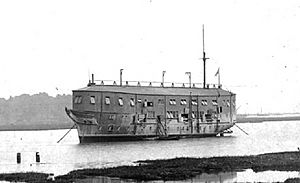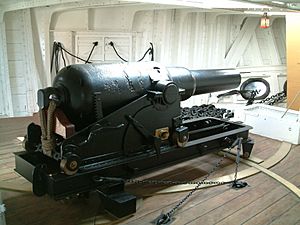HMS Gannet (1878) facts for kids

HMS Gannet in her dock in Chatham, 2005
|
|
Quick facts for kids History |
|
|---|---|
| Name | HMS Gannet |
| Builder | Sheerness Royal Dockyard |
| Cost | Hull £39,581, machinery £12,889 |
| Laid down | 1877 |
| Launched | 31 August 1878 |
| Commissioned | 17 April 1879 |
| Decommissioned | 16 March 1895 |
| Fate |
|
| General characteristics | |
| Class and type | Doterel-class screw composite sloop |
| Displacement | 1,130 tons |
| Length | 170 ft 0 in (51.8 m) pp |
| Beam | 36 ft 0 in (11.0 m) |
| Draught | 15 ft 9 in (4.8 m) |
| Installed power | 1,107 ihp (825 kW) |
| Propulsion |
|
| Sail plan | Ship-rigged originally and at present; barque-rigged in the middle of her career. |
| Speed | 11.5 knots (21.3 km/h; 13.2 mph) |
| Range | 1,480 nmi (2,740 km; 1,700 mi) at 10 knots (19 km/h; 12 mph) |
| Complement | 140 |
| Armament |
|
HMS Gannet was a special type of ship called a Royal Navy screw sloop-of-war. She was launched on August 31, 1878. A sloop-of-war was a small warship with a single gun deck. Gannet later became a training ship in the River Thames in 1903. From 1913, she helped train boys in the Hamble. In 1987, she was carefully restored. Today, she is part of the UK's National Historic Fleet, meaning she is an important part of the country's history.
Contents
Ship Design and Features
The Doterel-class ships, like Gannet, were built in a special way. They had wooden hulls (the main body of the ship) built over an iron frame. This was called "composite construction." The original design was updated in 1877, and nine ships of this type were ordered.
Gannet weighed about 1,130 tons. She had a powerful engine that produced around 1,100 indicated horsepower. Her main weapons were two large 7-inch guns. These were "muzzle-loading rifled guns," meaning they were loaded from the front and had grooves inside for better accuracy. She also carried four 64-pounder guns and several machine guns. A crew of about 140 sailors worked on board.
Building the Ship
Gannet was built at Sheerness Royal Dockyard. Construction began in 1877. She was officially launched into the water on August 31, 1878. The ship was ready for duty on April 17, 1879. She was known as both a sloop of war and a "colonial cruiser." This meant she could patrol and protect British interests in different parts of the world. Gannet could reach speeds of almost 12 knots (about 14 miles per hour) using her steam engine. She could go even faster, up to 15 knots, when using her sails.
Gannet in Action
Ships like Gannet had important jobs. They helped the British navy protect trade routes. They also worked to stop slavery and explored new areas.
Serving in the Pacific Ocean
Gannet began her first mission on April 17, 1879. She sailed to the Pacific Station, which was a naval base in the Pacific Ocean. Her journey took her from Portsmouth, England, across the Atlantic Ocean. She then sailed around Cape Horn at the tip of South America. She arrived at Panama City on the Pacific coast.
During this time, Gannet kept an eye on the War of the Pacific. This was a conflict between several South American countries. After her patrol around the Pacific, she returned to Sheerness in July 1883. The ship then underwent a two-year repair and upgrade period.
Adventures in the Mediterranean and Red Sea
Gannet started her next mission on September 3, 1885. She joined the Mediterranean Fleet. Her first task was to support British forces in the Sudan. She also patrolled the Red Sea, looking for ships involved in the slave trade.
In September 1888, Gannet was called to help at the port of Suakin, Sudan. This port was under attack. For nearly a month, Gannet fought against forces led by Osman Digna. She fired many shells from her main guns and machine guns to defend the port. On October 15, another ship took her place. Gannet then finished her mission in Malta on November 1, 1888.
Mapping the Seas
Soon after, on November 10, 1888, Gannet began a new job. She was assigned to survey work. This meant she would map and chart different areas of the Mediterranean Sea. She completed this mission in December 1891.
Her final mission started on January 26, 1892. For three years, she continued her important survey work in both the Mediterranean and the Red Sea. Gannet returned to Chatham and was officially taken out of service on March 16, 1895.
Later Life of Gannet
After her naval career, Gannet was used for other purposes.
Harbour Duties
In December 1895, Gannet was moved to Chatham to serve in the harbour. She stayed there until 1900. She was then leased to a railway company. She became an "accommodation hulk," which means she was used as a floating home for workers at Port Victoria railway station.
Training Ship President
In 1903, Gannet was chosen to replace an older training ship called HMS President. She was changed a lot to become a drill ship. Renamed HMS President, she became the main ship for the Royal Naval Volunteer Reserve in London in June 1903. In 1909, her name changed again to President II. By 1911, another ship took her place.
Dormitory Ship on the Hamble River
In 1913, Gannet was loaned to C. B. Fry, a famous sportsman. She was moved to the River Hamble. There, she became a dormitory ship for the Training Ship Mercury. She kept the name President during this time. The school helped young boys who might not have many chances in life. It trained them to join the Royal Navy. Gannet served in this role until the school closed in 1968.
Preserving a Piece of History
After the school closed, Gannet was given to the Maritime Trust. This group works to save historic ships. In 1987, the Chatham Historic Dockyard took over her care. They started a big project to restore the ship. Their goal was to make her look like she did in 1888. This was the only time she was involved in naval combat.
In 1994, the Chatham Historic Dockyard Trust became the official owner of Gannet. Today, she is listed as part of the National Historic Fleet. She is on display as a museum ship at Chatham, allowing visitors to learn about her long and interesting history.
Gannet in the News
In March 2009, something special happened. The Prime Minister of the United Kingdom, Gordon Brown, visited President Barack Obama at the White House. Prime Minister Brown gave President Obama a gift. It was a pen holder made from the wood of Gannet! This gift showed Gannet's important role in stopping slavery during the Victorian era. President Obama gave Prime Minister Brown a collection of 25 classic American movies in return.



